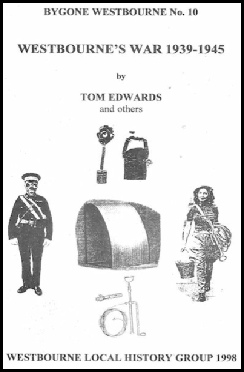
WESTBOURNE
A village history in West Sussex
PUBLICATIONS
Westbourne History Group
Bygone Series
No2. Village Schools 1819-
No9. The Bastards of Westbourne
No10. Westbourne’s War 1939-
No15. The Village Schools 1810-
No16. Westbourne and the Great War
No17. Tradespeople of Westbourne
Numbers 1 to 5 inclusive out of print, further information on details and costs visit:
www.westbournevillage.org
Home | Personal | Church | Scouts | Schools | Ambrose | Sketchbook | Workhouse | Census | Memories | Yesteryear | Publications | Village Website
 On the warm sunny morning of Sunday 3rd September 1939, after returning from Sunday School in the Tin Hut (Church Hall), I was playing in Hatchards Lane which we local boys regarded as our playground, when at about 11.25 am. we were told to go to our homes immediately as war had been declared. (This was announced on the wireless at 11.15 am. by the Prime Minister -
On the warm sunny morning of Sunday 3rd September 1939, after returning from Sunday School in the Tin Hut (Church Hall), I was playing in Hatchards Lane which we local boys regarded as our playground, when at about 11.25 am. we were told to go to our homes immediately as war had been declared. (This was announced on the wireless at 11.15 am. by the Prime Minister -
On arriving home, we all waited indoors for the rest of the day to see what might happen as everyone had some idea of taking “Air Raid Precautions”, which had been widely publicised even on cigarette cards during 1938-
Next day it appeared to me, a small boy, that life was back to normal, but little did I know that this was to be the start of possibly the most exciting period of my life; mixed with hardship and occasionally personal grief and sadness at the loss of family, relatives and friends. In some of the larger families this must and did sadly occur more often.
On returning to school after the Summer holidays we found we had many new school mates, when a large number of evacuees arrived -
This increased the school population overnight by, at a guess, 30% which meant very large classes, but with the leadership of a superb headmaster MR M.W. SIMMONDS and a very dedicated band of teachers, including my teacher at this time MR R. URRY, our basic education did not suffer too much
(How would we cope today?) -
Something I’ve always remembered was the large Royal Navy white ensign displayed on the wall in the assembly hall which I saw every morning at 9 o’clock prayers before the day’s school work began. Was it this flag or the tradition on my mother’s side of the family that always drew me towards the ……
Published 1998 ISBN 0 9507496 9 9
WESTBOURNE’S WAR 1939-